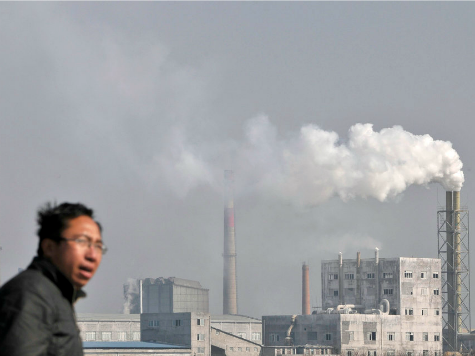
China’s “economic miracle” faces an existential threat now that the nation is the world’s largest importer of oil. The Chinese central authorities mandated a $275-billion crash investment in fracking to develop cheap energy from China’s 30 trillion cubic meters of natural gas trapped in the world’s largest shale fields. But China’s effort to knockoff America’s oil and gas fracking boom appears to have failed. China seems doomed to continue to destroy its industrial competitiveness by relying on high-cost energy imports.
The head of China’s National Energy Administration (CNEA) quietly admitted last week that the country’s bold effort to follow the United States’s lead in launching an oil and gas boom based on hydraulic fracking of shale is failing. CNEA central planners promised domestic fracking would produce 80 billion cubic meters of cheap natural gas a year by 2020. But CNEA’s estimate for domestic gas production has been revised down to just 30 billion cubic meters per year.
China became the largest global energy consumer in 2010 and passed the U.S. as the largest net oil importer in 2014. China relies on coal for 70% of its energy needs and 80% of its electricity. State-run Shenhua Energy is the world’s largest coal producer, and at 3.8 billion tons last year, China burned almost as much coal as the 4.3 billion tons for the rest of the world.
But smog from coal burning has skyrocketed along with China’s economic growth. China’s burning coal as its primary energy source explains why CO2 emissions grew by 44% over the last five years. The Earth Quality Institute ranked China the number one emitter of CO2 with 2,395 million tons produced in 2013. According to the World Bank, 16 of the world’s 20 most polluted cities are now in China.
In July of 2013, China announced a five-year, $275-billion investment focused on natural gas development to curb air pollution from burning coal. The central authorities also announced the “Clean Air Action Plan” in September as a mandate to convert coal power plants to natural gas to service key urban centers such as Beijing by 2020.
China deferred natural gas production due to inadequate pipeline infrastructure and an abundance of cheaper coal deposits. But China planned to raise annual consumption from 162 billion cubic meters of natural gas in 2013 to 400 billion cubic meters in 2024.
At more than 30 trillion cubic meters, China contains the world’s largest shale gas reserves. The central authorities expected to use fracking to knockoff America’s shale oil and gas boom, according to Stratfor Global Intelligence. China Petroleum & Chemical Corp. tried developing shale fields with domestic equipment and personnel but has not succeeded due to extreme technical and geological challenges.
China’s Yanchang Petroleum acquired Canada’s Novus Energy in January to develop gas from Shaanxi and neighboring Sichuan shale basins. But the area is mountainous and crisscrossed with deep earthquake faults. This not only limits horizontal drilling, but it also raised fears in the region that recent deadly earthquakes were caused by fracking. The combination of the local population’s environmental opposition and very high cost of shale gas development is limiting shale gas production.
Chevron spent $6.4 billion in China in hopes of bringing in a 12-billion-cubic-meters-per-year supply of Sichuan shale gas online by 2010. But production has been delayed until 2015 because of the area’s geological complexity. Chevron is now in a disagreement with its partners Petro China Company and the Chinese government on how to finish the project that is 36% over original estimated cost.
Beijing is cracking down on corruption at its state-owned energy giants PetroChina, Sinopec, and China National Petroleum Corp by taking away the companies’ power and influence as retaliation for failing to increase gas supplies, according to Stratfor.
In desperation to gain more foreign partners to develop natural gas, China has offered to set up an incentive program that includes a value-added tax refunds, direct subsidies, and waivers on import tariffs for equipment. China is raising the wholesale price of natural gas for traditionally subsidized industrial users by 20.5% and promises to completely deregulate all subsidized gas prices by September 1st to fund gas projects.
Unable to substantially increase domestic gas production, China has been forced to secure large volumes of pipeline natural gas from Turkmenistan and Myanmar. In May, China signed a $400 billion deal with Gazprom for 38 billion cubic meters a year of natural gas for 30 years.
China is also building import terminals to handle almost 70 billion cubic meters of liquefied natural gas (LNG) and has plans to add another 80 billion cubic meters. But it is doubtful that LNG supply contracts can come online fast, and the nation may be forced to try to buy much more expensive LNG on spot market.
China’s rising energy needs accounted for one third of the world’s oil consumption growth in 2013 and is projected grow at the same rate in 2014. The rising cost of imported energy is destroying China’s industrial competitiveness and helps explain why exports fell from 39% to 26% of China’s GDP over the last five years. But with national effort to produce oil & gas by fracking of shale deposits now a failure, China’s economic miracle is increasingly threatened by the high cost of imported energy.

COMMENTS
Please let us know if you're having issues with commenting.